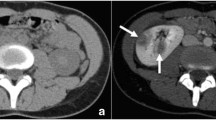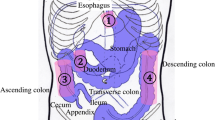Abstract
Purpose
To determine the accuracy of split-bolus CT urogram (SB-CTU) without special maneuvers for ureteral distention in diagnosing upper urinary tract urothelial carcinoma (UCA).
Materials and methods
A hospital database was searched from 1/1/10, to 9/1/15, for SB-CTU exams without special maneuvers for ureteral distention. Accuracy of SB-CTU for detecting upper and lower urinary tract UCA was computed by comparing the prospective radiology report with cystoscopy, ureteroscopy, and/or urologic clinical follow-up. Patients with less than 12 months of clinical follow-up were excluded.
Results
339 studies were identified in 334 patients (60% male 40% female, avg. age 64). 119 studies were performed for microhematuria, 150 for gross hematuria, 13 for hematuria not otherwise specified, 57 for history of UCA, and one for a collecting system mass on a prior CT. There were five upper tract and 33 bladder tumors with overall prevalence of 1.5% and 9.7%, respectively. The prevalence varied significantly with patient age and clinical indication for SB-CTU. There were one false negative and four false positives for upper urinary tract UCA. Sensitivity, specificity, positive predictive value, and negative predictive value for detecting upper tract and bladder tumors were 80%, 99%, 44%, and 100%, respectively, and 55%, 98%, 78%, and 95%, respectively.
Conclusion
Based on this study, SB-CTU without special maneuvers for ureteral distention is highly sensitive for detecting upper tract UCA, although with a low positive predictive value, false positives do occur. The clinical utility of increasing accuracy in diagnosing this low-prevalence disease through other more complex CT urogram protocols should be weighed against the added cost and radiation dose associated with these protocols.






Similar content being viewed by others
References
Davis R, Jones JS, Barocas DA, et al. (2012) Diagnosis, evaluation and follow-up of asymptomatic microhematuria (AMH) in adults: AUA guideline. J Urol 188(6 Suppl):2473–2481
McTavish JD, Jinzaki M, Zou KH, Nawfel RD, Silverman SG (2002) Multi-detector row CT urography: comparison of strategies for depicting the normal urinary collecting system. Radiology 225(3):783–790
Silverman SG, Akbar SA, Mortele KJ, et al. (2006) Multi-detector row CT urography of normal urinary collecting system: furosemide versus saline as adjunct to contrast medium. Radiology 240(3):749–755.
Mawhinney RR, Gregson RH (1987) Is ureteric compression still necessary? Clin Radiol 38(2):179–180
Chow LC, Sommer FG (2001) Multidetector CT urography with abdominal compression and three-dimensional reconstruction. AJR Am J Roentgenol 177(4):849–855
Maheshwari E, O’Malley ME, Ghai S, Staunton M, Massey C (2010) Split-bolus MDCT urography: upper tract opacification and performance for upper tract tumors in patients with hematuria. AJR Am J Roentgenol 194(2):453–458
Chow LC, Kwan SW, Olcott EW, Sommer G (2007) Split-bolus MDCT urography with synchronous nephrographic and excretory phase enhancement. AJR Am J Roentgenol 189(2):314–322
Caoili EM, Cohan RH, Inampudi P, et al. (2005) MDCT urography of upper tract urothelial neoplasms. AJR Am J Roentgenol 184(6):1873–1881
Sadow CA, Wheeler SC, Kim J, Ohno-Machado L, Silverman SG (2010) Positive predictive value of CT urography in the evaluation of upper tract urothelial cancer. AJR Am J Roentgenol 195(5):W337–W343
Sudakoff GS, Dunn DP, Guralnick ML, et al. (2008) Multidetector computerized tomography urography as the primary imaging modality for detecting urinary tract neoplasms in patients with asymptomatic hematuria. J Urol 179(3):862–867
Sadow CA, Silverman SG, O’Leary MP, Signorovitch JE (2008) Bladder cancer detection with CT urography in an Academic Medical Center. Radiology 249(1):195–202
Turney BW, Willatt JM, Nixon D, Crew JP, Cowan NC (2006) Computed tomography urography for diagnosing bladder cancer. BJU Int 98(2):345–348
Clopper CJ, Pearson ES (1934) The use of confidence or fiducial limits illustrated in the case of the binomial. Biometrika 26:404–413
Mercaldo ND, Lau KF, Zhou XH (2007) Confidence intervals for predictive values with an emphasis to case-control studies. Stat Med 26(10):2170–2183
Altman DG (2000) Statistics with confidence: confidence intervals and statistical guidelines. 2nd edn. London: BMJ Books. xii
Jemal A, Siegel R, Ward E, et al. (2007) Cancer statistics, 2007. CA Cancer J Clin 57(1):43–66
Tran W, Serio AM, Raj GV, et al. (2008) Longitudinal risk of upper tract recurrence following radical cystectomy for urothelial cancer and the potential implications for long-term surveillance. J Urol 179(1):96–100
Millan-Rodriguez, F, Chechile-Toniolo G, Salvador-Bayarri J, Huguet-Pérez J, Vicente-Rodríguez J (2000) Upper urinary tract tumors after primary superficial bladder tumors: prognostic factors and risk groups. J Urol 164(4):1183–1187
Edwards TJ, Dickinson AJ, Natale S, Gosling J, Mcgrath JS (2006) A prospective analysis of the diagnostic yield resulting from the attendance of 4020 patients at a protocol-driven haematuria clinic. BJU Int 97(2):301–305
Van Der Molen AJ, Cowan NC, Mueller-Lisse UG, et al. (2008) CT urography: definition, indications and techniques. A guideline for clinical practice. Eur Radiol 18(1):4–17
Chlapoutakis K,Theocharopoulos N, Yarmenitis S, Damilakis J (2010) Performance of computed tomographic urography in diagnosis of upper urinary tract urothelial carcinoma, in patients presenting with hematuria: systematic review and meta-analysis. Eur J Radiol 73(2):334–338
Author information
Authors and Affiliations
Corresponding author
Ethics declarations
Funding
No funding was received for this study.
Conflict of interest
The authors declare that they have no conflict of interest.
Ethical approval
All procedures performed in studies involving human participants were in accordance with the ethical standards of the institutional and/or national research committee and with the 1964 Helsinki declaration and its later amendments or comparable ethical standards. For this type of study formal consent is not required.
Informed consent
Statement of informed consent was not applicable since the manuscript does not contain any patient data.
Rights and permissions
About this article
Cite this article
Shaish, H., Newhouse, J.H. Split-bolus CT urogram: Is less more?. Abdom Radiol 42, 2119–2126 (2017). https://doi.org/10.1007/s00261-017-1098-3
Published:
Issue Date:
DOI: https://doi.org/10.1007/s00261-017-1098-3




